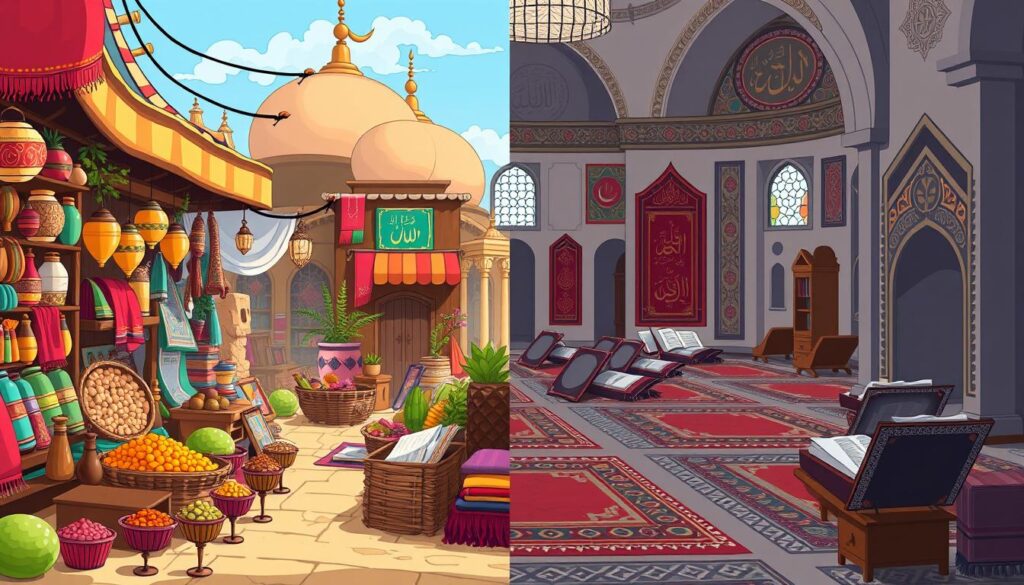As we start exploring Islamic traditions, it’s crucial to know the difference between Cultural vs. Religious Practices in our faith. Our cultural backgrounds shape how we show our beliefs. However, Islamic rituals always follow the Quran and Sunnah. It’s important to understand the culture and religion are different. This helps us respect and value the various experiences of Muslims all over the world.
Muslims make up about 25% of the world’s population, being one of the biggest religious groups. They are expected to increase greatly in the future. It’s important to know the difference between cultural traditions and religious rituals. This knowledge can fight against the wrong ideas and stereotypes that come from oversimplifying.
In this journey to understand Islamic practices better, we’ll show how learning and talking openly can connect cultural details with religious rules. We invite you to join this important conversation. You’ll get to know more about the rich mix of traditions that make up our Muslim identity. For those finding their way in Islam, resources like tips for converts can be very helpful.
Key Takeaways
- The distinction between cultural and religious practices is crucial for understanding Islamic traditions.
- Islamic rituals are based on the Quran and Sunnah, regardless of cultural interpretations.
- Recognizing cultural diversity enhances appreciation for different Muslim experiences.
- Education is key to dispelling misconceptions surrounding Islam.
- Promoting interfaith understanding fosters respect and community.
Defining Cultural Practices in Islam
In Islam, understanding the line between cultural practices and religious customs is key. Cultural practices come from a place’s history, its people, and their ways. They often show the area’s cultural background more than strict religious rules. This creates a rich variety across Muslim communities.
What Constitutes Cultural Practices?
Cultural practices in Muslim communities are shaped by social habits. These are often influenced by Islam blending with local customs over time. Key factors in these practices include:
- Historical experiences specific to a region.
- Ethnic identities that shape community behaviors.
- Geographical contexts influencing local traditions.
These practices are deeply meaningful, linking people to their heritage. Cultural beliefs and religious customs greatly define a community’s values and standards.
Examples of Cultural Traditions in Muslim Societies
In the Muslim world, cultures vary widely, reflecting each area’s uniqueness. For instance:
- In South Asia, wedding celebrations are rich with rituals and colorful outfits, showing deep cultural roots.
- The Middle East has unique eats during Ramadan, showcasing the area’s tastes and traditions.
- Urdu literature’s use of Persian art styles shows how cultures blend over time.
This variety shows that Islam brings people together, but cultural traditions can be quite different. These differences, where tradition meets culture, make the Islamic experience richer. It’s important to see these unique practices when we talk about faith.
Understanding Religious Practices in Islam
Religious practices in Islam are central to a Muslim’s life and faith. They show how deeply believers connect with their religion and God. By following the Islamic worship rules, people go on a spiritual journey. This journey includes the Five Pillars of Islam, important for daily life and helping others in the community.
Key Elements of Islamic Worship
The heart of Islamic worship lies in the Five Pillars. Each Muslim follows these key practices:
- The Declaration of Faith (shahada): Reminds Muslims daily of God’s unity, deepening faith through regular repetition.
- Prayer (salat): Done five times every day, it links people spiritually to God and reminds them of their responsibilities.
- Charity (zakat): Muslims give part of their wealth yearly, aiming for social fairness.
- Fasting (sawm): During Ramadan, fasting from dawn to dusk focuses on self-cleanse and self-reflection.
- Pilgrimage (hajj): A journey that brings Muslims worldwide together, strengthening their sense of unity.
Important Religious Practices during Ramadan
Ramadan is known for its intense religious devotion. It’s a time for thinking deeply, praying, and building community ties. During Ramadan, around 90% of Muslims fast from dawn to dusk. This fasting encourages empathy and thankfulness, and supports spiritual and ethical development.
When the fast ends at sunset, communities come together for Iftar meals, strengthening friendships and family connections. Charity becomes even more important, with many increasing their zakat giving to help those in need. Ramadan brings Muslims together, helping them grow closer to God and each other.

The Role of Culture in Islamic Identity
Culture has a big impact on Muslims worldwide, shaping how they see the world. With about 1.9 billion Muslims, their cultural identity combines tradition with religion. This mix creates a special link between what they do and what they believe.
How Culture Shapes Muslim Experiences
Culture and religion in Islam are closely linked, affecting how people worship and interact. Traditions help people show their faith and respect their background. Around 70% of British Muslims feel a strong connection to their society. This shows that being part of a culture can make Islamic identity stronger.
- An emphasis on collective activities during religious celebrations.
- Local customs that enrich communal prayers and rituals.
- Generational variations in cultural practices as observed in immigrant families.
Young Muslims in the West often feel more connected to Western culture than their parents. About 58% of them identify more with Western ways. They try to find a balance between tradition and modern life.
The Interplay of Tradition and Religion
Tradition and religion often blend smoothly or sometimes clash within Islam. For example, 40% of Western Muslims find it hard to mix their traditions with today’s culture. This leads to different ideas about what being Muslim means across generations. About 30% of first-generation Muslim immigrants see their ways differently from the younger ones.
| Aspect | First-Generation Muslims | Second/Third-Generation Muslims |
|---|---|---|
| Identification with cultural practices | Struggle to reconcile with Islamic norms | Greater alignment with Western norms |
| Sense of belonging | Acculturation challenges | Strong local identity |
| Cultural expression | Focused on origin | Emphasizes hybrid identities |
Cultural identity in Islam is more than just a setting for religion. It’s an active force that shapes people’s lives. It builds resilience, helping Muslims value their heritage while meeting modern challenges.
Differences Between Cultural and Religious Practices
Understanding the differences between cultural and religious practices is key to appreciating Muslim life worldwide. Cultural practices are shaped by local contexts. Religious practices come from Islam’s teachings. Recognizing how these differ shows the balance between cultural diversity and religious traditions.
Distinguishing Characteristics
The main differences are where they come from and how they are shown. Cultural practices grow from history, ethnicity, and the environment. They lead to unique celebrations, foods, and social habits that show local traditions. In contrast, religious practices are based on established doctrines. They bring believers together through rituals like daily prayers and fasting during Ramadan. Knowing these differences helps us understand Muslim identity better.
Factors Influencing Cultural Variations
Many factors make the Muslim community culturally diverse. Geography influences cultural diversity due to different historical experiences and cultural interactions. Ethnicity also plays a role; for instance, Shia and Sunni communities celebrate events differently. Politics can affect how faith is expressed, especially in places where religion and government are linked. These factors show why cultural diversity and religious traditions vary in different communities.

Influence of Geography on Practices
Geography significantly shapes Islam’s varied expressions worldwide. Different landscapes and weather lead to unique religious practices. By studying these variations, we learn more about Islam’s local traditions.
Regional Differences in Islamic Cultures
Islamic teachings vary by region due to geography. This impact is visible in different areas:
- In the Middle East, traditional practices may focus more on communal prayers and gatherings.
- Southeast Asian cultures often incorporate local elements, such as traditional music and dance, into Islamic celebrations.
- North African countries incorporate Berber customs, enriching the local flavor of Islamic observance.
Local Customs Impacting Religious Observance
Local traditions heavily influence religious practices. The blend of culture and geography leads to unique Islamic practices. These adaptations create personal expressions of faith.
| Region | Local Customs | Religious Observance |
|---|---|---|
| Middle East | Daily communal prayers | Stronger emphasis on the mosque as a community center |
| Southeast Asia | Integration of traditional arts | Cultural performances during religious festivals |
| North Africa | Berber traditions | Unique forms of dress during religious ceremonies |
Understanding these regional differences deepens our insight into Islamic practices worldwide. It shows how local traditions within the faith’s framework make it rich and diverse. Each community adds to Islam’s unity while celebrating its diversity.
The Impact of Globalization on Practices
Globalization changes how we understand Islamic practices today. In our connected world, cultural expressions and religious practices shift. This happens due to new technology and worldwide communication. These changes mix traditions but also remind us to keep Islamic values in today’s world.
How Technology Affects Cultural Transmission
Technology links Muslim communities around the world. The internet and social media spread knowledge. This lets people share ideas, beliefs, and practices. Islam and other major religions use online tools to offer insights. This creates a deep conversation among believers.
This tech wave makes it easier to find religious content. It helps people feel part of a community, even if they’re far from traditional ones. We see new forms of Islamic traditions emerging. They respect both old customs and new ways.
The Blend of Traditions in Modern Society
Globalization mixes cultural traditions in interesting ways. This leads to richer religious experiences. People from different backgrounds share and learn from each other. This promotes respect and understanding across cultures. Values like peace and respect grow among different faiths.
But, blending traditions can be tricky. While some find strength in new practices, others turn back to old ways for comfort. This shows the balance between keeping traditions and adapting to new times.

Case Study: Festivals in Islamic Cultures
Islamic festivals bring people together for shared joy and spiritual moments. Eid al-Fitr is one of these special times, marking the end of Ramadan. It is a day filled with happiness, thankfulness, and community spirit for Muslims everywhere. The way Eid al-Fitr is celebrated varies by region, showing the rich diversity within the culture.
Eid al-Fitr: A Religious Celebration
The celebration starts with a special prayer in a large group. This shows how important praying together is. Giving to others, through zakat al-fitr, is also key. It ensures everyone can enjoy the festive time. Dressing up and sharing delicious traditional foods represent unity and care.
Cultural Variations in Eid Celebrations
Different countries have their unique ways of celebrating Eid al-Fitr. For example:
- In Indonesia, people enjoy special foods like ketupat and rendang.
- In Turkey, the streets glow with lights and people enjoy baklava.
- Saudia Arabia comes alive with social events, music, and dancing.
Each country’s celebrations show their own traditions but also bring families and communities closer. Knowing about these different customs helps us see the beauty in Islamic festivals. Celebrating Eid al-Fitr, we join in the happiness and respect our diverse but united community.
Role of Family in Cultural and Religious Practices
Families are key in shaping cultural and religious identities in Islam. They provide moments to reinforce Islamic values during gatherings. These events strengthen family ties and help pass traditions to younger Muslims. This ensures the faith’s core principles stay vibrant in their hearts.
Family Gatherings and Religious Observance
Family gatherings blend with religious events, making space for shared worship. These times show the family’s role in Islamic culture. A lot of Americans see the value of religious life at home. For example, 91% of those attending weekly services say it’s important in their families. This link between family and faith fosters community and purpose.
Transmission of Traditions Across Generations
Passing traditions down is key for cultural continuity. Parental faith greatly affects children’s spiritual paths. Close families often keep their faith strong across generations. This shows the importance of keeping connections.
Research indicates 93% of weekly service-going parents think their kids will follow their faith. This underlines family’s role in religious practice.
| Family Structure | Religious Influence | Impact on Children |
|---|---|---|
| Traditional Nuclear Family | High | Stronger likelihood of maintaining religious practices |
| Blended Families | Moderate | Varied religious beliefs can lead to diverse practices |
| Single-Parent Families | Variable | Dependent on individual commitment |
| Extended Families | High | Shared practices reinforce religious identity |
The family’s role in Islamic culture is crucial for a strong religious identity. Family gatherings and tradition sharing enrich lives and the community. Together, families foster an environment where faith grows and lasts.
Addressing Misconceptions
Often, people misunderstand Islam because they don’t know much about it. Open conversations can help clear up these common false beliefs. It’s important to realize that people, and what they believe in, can be very different.
This helps everyone understand and respect each other, both within the Muslim world and outside of it.
Common Misunderstandings About Islam
We need to look at some wrong ideas about Islam that make people see it negatively. These wrong ideas include:
- Thinking all Muslims are extremists, which is not true because most of them want peace.
- Seeing Sharia as only strict and unforgiving, without seeing its basis in fairness and kindness.
- Believing Islam is against women, while not noticing its teachings that actually empower women.
By correcting these misunderstandings, we help everyone grow and understand each other better.
Education as a Tool for Clarifying Differences
Learning about Islamic practices shines a light on understanding. Efforts to share correct information bring people closer.
Hosting programs and workshops allows for deep talks about Islam’s details. This shows us that:
- Islam has many different ways it can be interpreted and practiced, showing the diversity of its people.
- Education builds empathy, helping us see the many distinct identities in the Muslim community.
- Knowing more can fight against prejudice and break down wrong stereotypes about Islam.
Educational efforts help us appreciate the wide array of Islamic traditions and cultures.
The Importance of Respecting Differences
Respecting different cultures and religions makes our communities better. It lets us understand various groups more deeply. We can work together towards common goals, valuing each culture’s uniqueness.
Building cultural bridges is key. It creates spaces where everyone feels important and respected.
Promoting Interfaith Understanding
Talking to people from various beliefs helps us respect each other. By learning about different faiths, we begin to understand and empathize with others. We find common ground despite our differences.
Promoting dialogues between faiths brings many advantages, such as happier employees in diverse workplaces and better teamwork.
- A 30% increase in employee satisfaction among diverse religious affiliations in inclusive workplaces.
- A 25% reduction in employee turnover rates when organizations accommodate religious practices.
- A 20% improvement in collaboration and team dynamics as a result of promoting religious inclusivity.
Building Bridges Between Cultures and Religions
Efforts to connect different cultures and faiths boost our problem-solving skills. Teams from various religious backgrounds are 35% more likely to succeed. Welcoming cultural differences brings clear benefits.
- Increased productivity by 15% when flexible scheduling for religious observances is implemented.
- A 50% reduction in complaints related to religious bias through clear policies against religious discrimination.
- Positive impacts on workplace morale when employees feel their religious practices are respected.

Understanding and respecting different faiths greatly enhance collaboration and growth. This approach helps us see individuals as unique, breaking stereotypes. It makes both our communities and workplaces richer.
Conclusion: Embracing Diversity in Islam
The journey through Islamic traditions shows us something important: the power of recognizing unique practices worldwide. Embracing diversity within Islam makes our community richer and our faith stronger. The Qur’an tells us that our different languages and cultures show Allah’s wisdom. It wants us to celebrate, not fear, our differences.
By understanding the value of diverse backgrounds, we grow in empathy and respect. This ensures that every voice is heard and valued.
The Value of Recognizing Unique Practices
Every cultural practice in Islam means something special, shaping how we experience our faith. Historical figures, like Salman the Persian, show how diversity strengthened the community. They did this without losing their identities. Recognizing unique practices helps us see the strength in our diversity. This lays the groundwork for conversation and teamwork in our communities.
Joining cultural events and interfaith dialogues helps us understand each other better. It shows that our differences can make things better for everyone.
Encouraging Dialogue and Cooperation
Open dialogue and working together help us connect different Islamic cultures. Talking and engaging with one another brings more tolerance. This bond enhances our social ties and participation in the community. Reflecting on the Quran and our faith’s history, we’re urged to appreciate these unique views.
By fostering a team spirit, we aim to create a global Muslim community that is supportive and unified. This community will embrace its varied identities.






